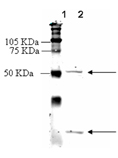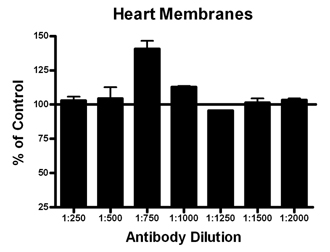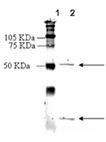Product Details
| Alternative Name: | EDNRA, ETA |
| |
| Host: | Rabbit |
| |
| Immunogen: | Synthetic peptide corresponding to the sequence near the N-terminus of rat endothelin receptor ETA. |
| |
| UniProt ID: | P26684 |
| |
| Species reactivity: | Rat
|
| |
| Crossreactivity: | Predicted species reactivity based on epitope sequence homology: human, mouse, dog, horse, rhesus macaque, bovine, chimpanzee, platypus, wild boar, opossum, rabbit. |
| |
| Applications: | ELISA, IHC, WB
|
| |
| Application Notes: | Suitable for membrane-based ELISA.
Predicted MW of ~48kDa and ~21kDa (C-13 alternative splice variant) species are membrane integrated, with higher MW species observed by Western blot due to postranslational modification or heterodimerization of the receptor. |
| |
| Purity Detail: | Peptide affinity purified. |
| |
| Formulation: | Liquid. In PBS containing 50% glycerol and 0.01% sodium azide. |
| |
| Handling: | Keep on ice at all times. |
| |
| Shipping: | Blue Ice |
| |
| Long Term Storage: | -20°C |
| |
| Scientific Background: | Endothelins are vasoactive peptides that exist in three forms (ET-1, ET-2, and ET-3), and function in the maintenance of vascular tone via two identified seven transmembrane-spanning domain-containing G protein-coupled receptors (GPCR), endothelin A (ETA) and endothelin B (ETB). The human ETA receptor is primarily expressed in vascular smooth muscle cells, including those of the heart (also in myocytes), lung, and brain, and its stimulation generally results in vasoconstriction. Activation of ETA receptors can be stimulated by binding of ET-1 and ET-2, but not ET-3. triggering the release of vasorelaxive factors such as nitric oxide (NO) and prostanoids from endothelial cells. Human ETB receptors are primarily expressed in endothelial cells lining the vessel walls of the lungs, heart, and brain, and in contrast to ETA receptors, stimulation generally results in transient vasodilation. Activation of ETB receptors can be stimulated by binding of all three endothelins, triggering the release of vasorelaxive factors such as nitric oxide (NO) and prostanoids from endothelial cells. Both ETA and ETB receptors signal primarily via coupling to Gq/11 alpha subunits, although Gi/o and Gs coupling are also established mechanisms of endothelin signaling, resulting in stimulation of phospholipases C, A2, and D. |
| |
| Regulatory Status: | RUO - Research Use Only |
| |
| Manufacturer: | Manufactured by Proteimax. |
| |

Western blot analysis: MW marker (1) and 50µg of rat heart membrane extract (2) probed with Endothelin Receptor (ETA) pAb at 2.7µg/ml

Membrane ELISA: Lewis rat heart membranes (5µg/well) were treated with 1 μM concentrations of agonist (ET-1) and probed with receptor antibody (1:250 to 1:2000 of a 1µg/μl stock solution) by ELISA. Data from vehicle treated cells were taken as 100%. Results are the mean ± SEM (n=4).
Please mouse over
Product Literature References
Fibroblast growth factor and endothelin-1 receptors mediate the response of human striatal precursor cells to hypoxia: S. Ambrosini, et al.; Neuroscience
289C, 123 (2015),
Application(s): Western Blotting,
Abstract;
Related Products












